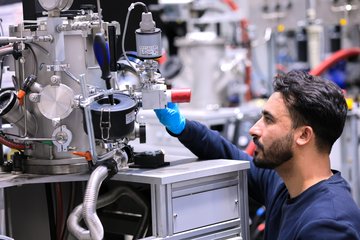All genres
2041.
Talk
News from the Iron Age – 3D EBSD and fresh Lobster. Anorganisch-Chemisches Kolloquium der Fakultät für Chemie, TU Dresden und Max-Planck-Instituts für Chemische Physik fester Stoffe, Dresden, Germany (2005)
2042.
Talk
Structure and Mechanical Properties of the Cuticle of the Lobster. MRS Spring Meeting, San Francisco, CA, USA (2005)
2043.
Talk
Texture and Smart Anisotropy of the Exoskeleton Tissue of Lobster. MRS Spring Meeting 2005, San Francisco, CA, USA (2005)
2044.
Talk
Mechanical Properties of the Lobster Cuticle. MRS Spring Meeting, San Francisco, CA, USA (2005)
2045.
Talk
The Future of Steels. keynote lecture, 20. Aachener Stahl Kolloquium, Aachen, Germany (2005)
2046.
Talk
Investigation of orientation gradients around particles and their influence on particle stimulated nucleation in a hot rolled Fe3Al based alloy by applying 3D EBSD. DPG Frühjahrstagung, Berlin, Germany (2005)
2047.
Talk
Texture analysis of Fe–Si steels. Jahreshauptversammlung der Deutschen Physikalischen Gesellschaft, Berlin, Germany (2005)
2048.
Talk
The Goss texture formation in silicon steels: Oriented nucleation or growth selection? DPG Frühjahrstagung, Berlin, Germany (2005)
2049.
Talk
Characterization of nanostructured electrodeposited NiCo Samples by use of Electron Backscatter Diffraction (EBSD). MRS Spring Meeting, San Francisco, CA, USA (2005)
2050.
Talk
Kristallmechanik in Metallen und Polymeren. Vom Werkstoffverständnis zum Wettbewerbsvorteil, Fraunhofer Institut für Werkstoffmechanik, Freiburg (2005)
2051.
Talk
Simulationen und Experimente zur Kristallmechanik. Colloquium at MPI für Mathematik in den Naturwissenschaften, Leipzig, Germany (2005)
2052.
Talk
Simulationen und Experimente zur Kristallmechanik. Instituts-Kolloquium am Institut für Festkörper- und Werkstoffforschung (IFW), Dresden, Germany (2005)
2053.
Talk
A texture evolution study using the Texture Component Crystal Plasticity FEM. Plasticity 2005, Kauai, USA (2005)
2054.
Talk
A dislocation density based constitutive model for crystal plasticity FEM. Plasticity 2005, Kauai, USA (2005)
2055.
Talk
Textures of Nanocrystalline CoNi. MRS Spring Meeting, San Francisco, CA, USA (2005)
2056.
Talk
The role of texture and anisotropy in nano- and microscale materials mechanics. Keynote lecture at the Plasticity Conference 2004/2005, Hawai, USA (2005)
2057.
Talk
Using the Lattice Boltzmann Method for Multiscale Modeling in Materials Science and Engineering. Lecture at the Plasticity Conference 2004/2005, Hawai, USA (2005)
2058.
Talk
Microstructure and Mesostructure of the exoskeleton of the lobster homarus americanus. MRS Spring Meeting, San Francisco, CA, USA (2005)
2059.
Talk
Crystal Plasticity Simulations in Materials Testing. Keynote lecture at the International Materials Testing Conference, Neu-Ulm (2004)
2060.
Talk
Crystal Mechanics in Metals and Polymers – Experiments and Simulations. Colloquium Lecture at Forschungszentrum Karlsruhe, Karlsruhe (2004)











